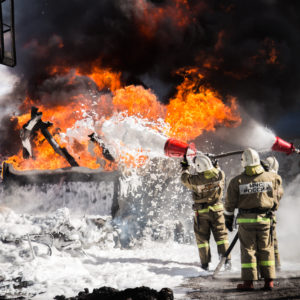Bladder Cancer Lawsuit Filed By Firefighter Exposed To Toxic Film-Forming Foam

A California man has filed a product liability lawsuit over a bladder cancer diagnosis he indicates resulted from exposure to aqueous film-forming foams (AFFFs) used during his work as firefighter.
The complaint (PDF) was filed by Lon Holliday, Jr. in the U.S. District Court for the District of South Carolina on September 28, alleging that various manufacturers of the firefighting foam sold an unreasonably dangerous product and failed to warn firefighters about the toxic side effects.
The film-forming foams have been widely used in prior decades at military bases and by some civilian firefighting organizations during training exercises and in response to certain fuel-based fires. The toxic AFFF involved the use of per- and polyfluoroalkyl substances (PFAS), which are toxic and carcinogenic chemicals that are known to build up on the body and increase the risk of cancer and other health problems.

Learn More About
Exposure to firefighting foam chemicals may result in an increased risk of cancer for firefighters, military and airport personnel.
Learn More About this Lawsuit SEE IF YOU QUALIFY FOR COMPENSATIONHolliday has named 3M Company, Buckeye Fire Equipment Company, Chemguard, Inc., Chemours Company, Chubb Fire, Ltd., Arkema, Inc., Du Pont De Nemours Inc., Kidde-Fenwal, Inc., Kidde, National Foam Inc. Tyco Fire Products, and others as defendants, indicating that each of the companies had a role in the production or sale of the toxic foam during the time he was exposed while working as a military or civilian firefighter.
“The Plaintiff directly used, was exposed, and/or was given AFFF to help fight fires on a regular basis,” Holliday’s complaint states. “The Plaintiff was never informed that this product was inherently dangerous. Nor was the Plaintiff warned about the known health risks associated with this product.”
The lawsuit indicates Holliday was diagnosed with bladder cancer, which was a direct result of exposure to the film-forming products sold by the defendants.
PFAS chemicals contained in AFFF are projected to take thousands of years to degrade, and past studies have shown their ability to enter and stay in the environment and human body through the air, dust, food, soil, and water. Previous U.S. Centers for Disease Control and Prevention (CDC) studies have shown PFAS chemicals primarily settle into the blood, kidney and liver, and could likely be detected in the blood of 98% of the U.S. population.
The toxic chemicals were first introduced into the manufacturing industry in the 1940’s, because of their ability to resist heat, grease, stains, and water. However, since then the chemicals have been linked to a myriad of adverse health effects including liver damage, thyroid disease, decreased fertility, high cholesterol, obesity, hormone suppression, and cancer.
The complaint joins other firefighting foam lawsuits, which have been filed over testicular cancer, kidney cancer, pancreatic cancer and other injuries.
Given common questions of fact and law raised in the litigation, all cases filed throughout the federal court system are currently centralized in the U.S. District Court for the District of South Carolina for coordinated discovery and pretrial proceedings.
Get more articles like this sent directly to your inbox.
"*" indicates required fields






0 Comments